
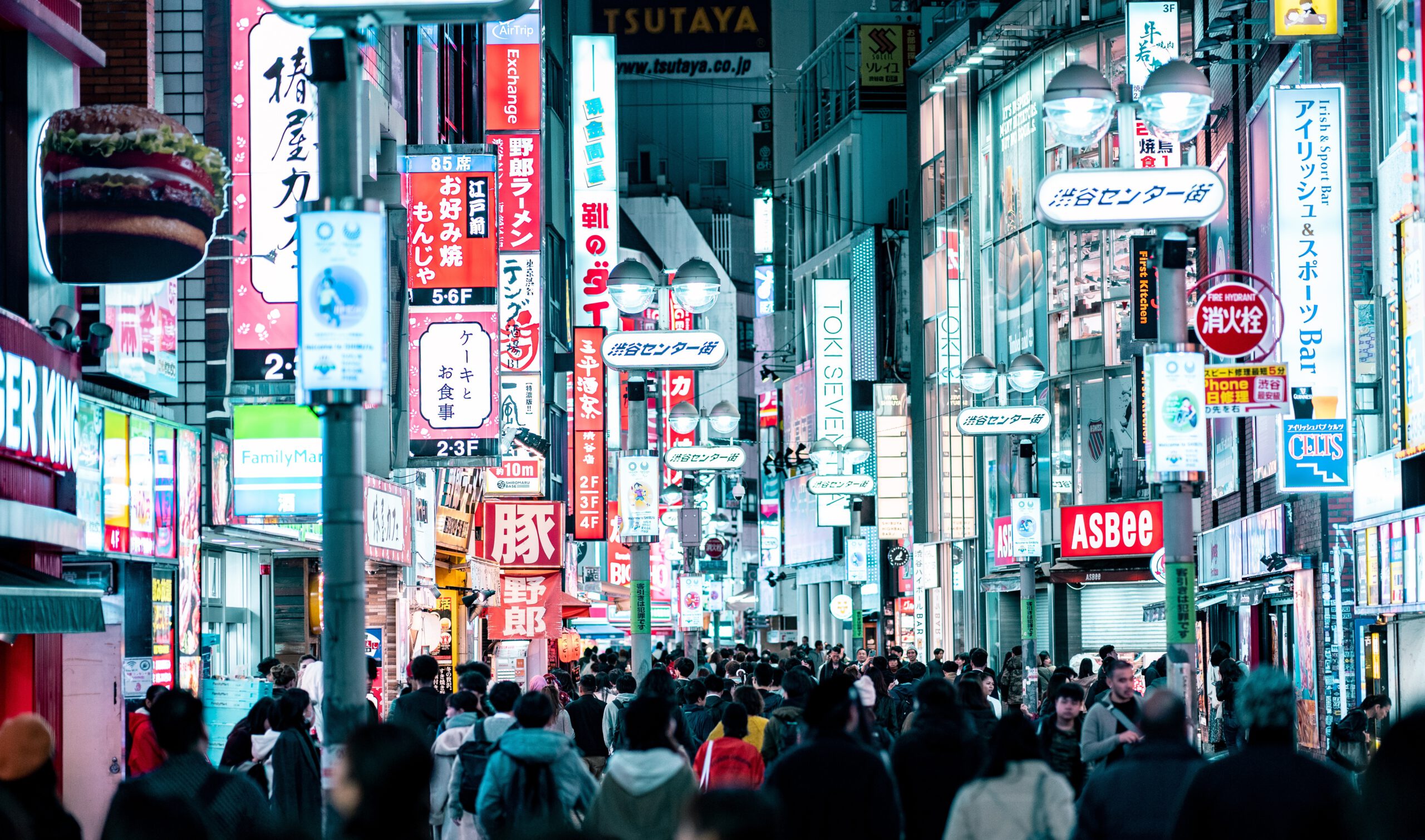
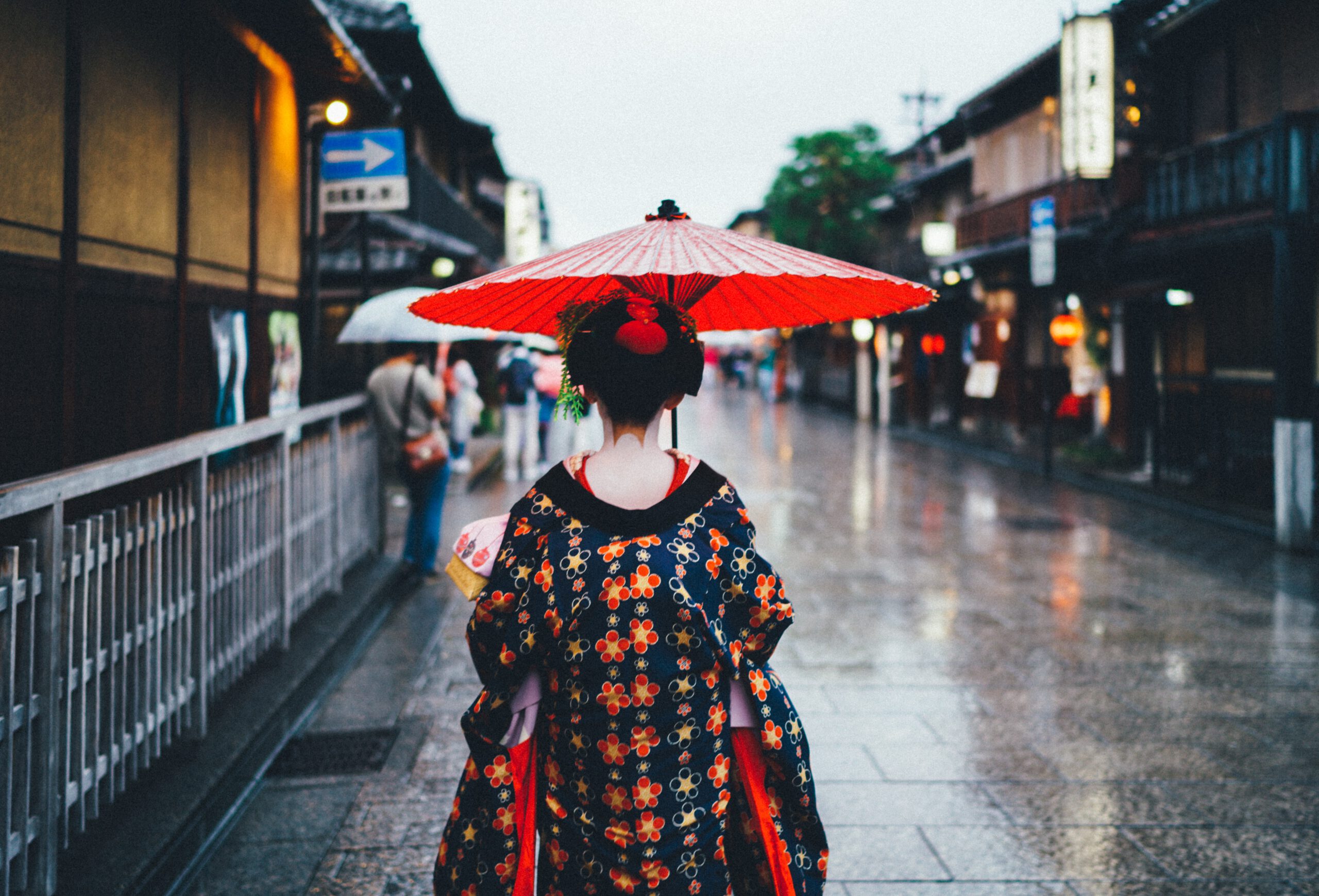
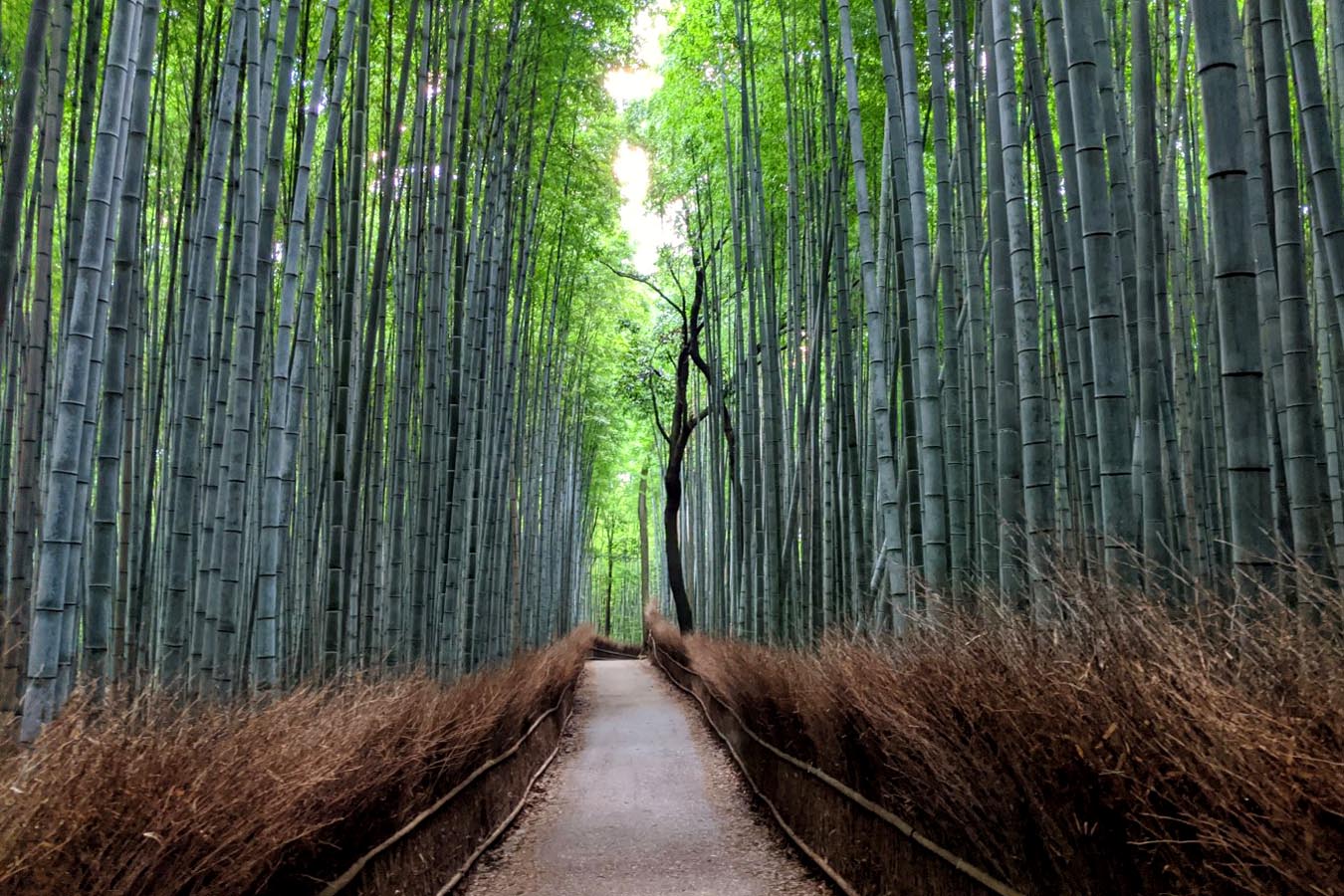
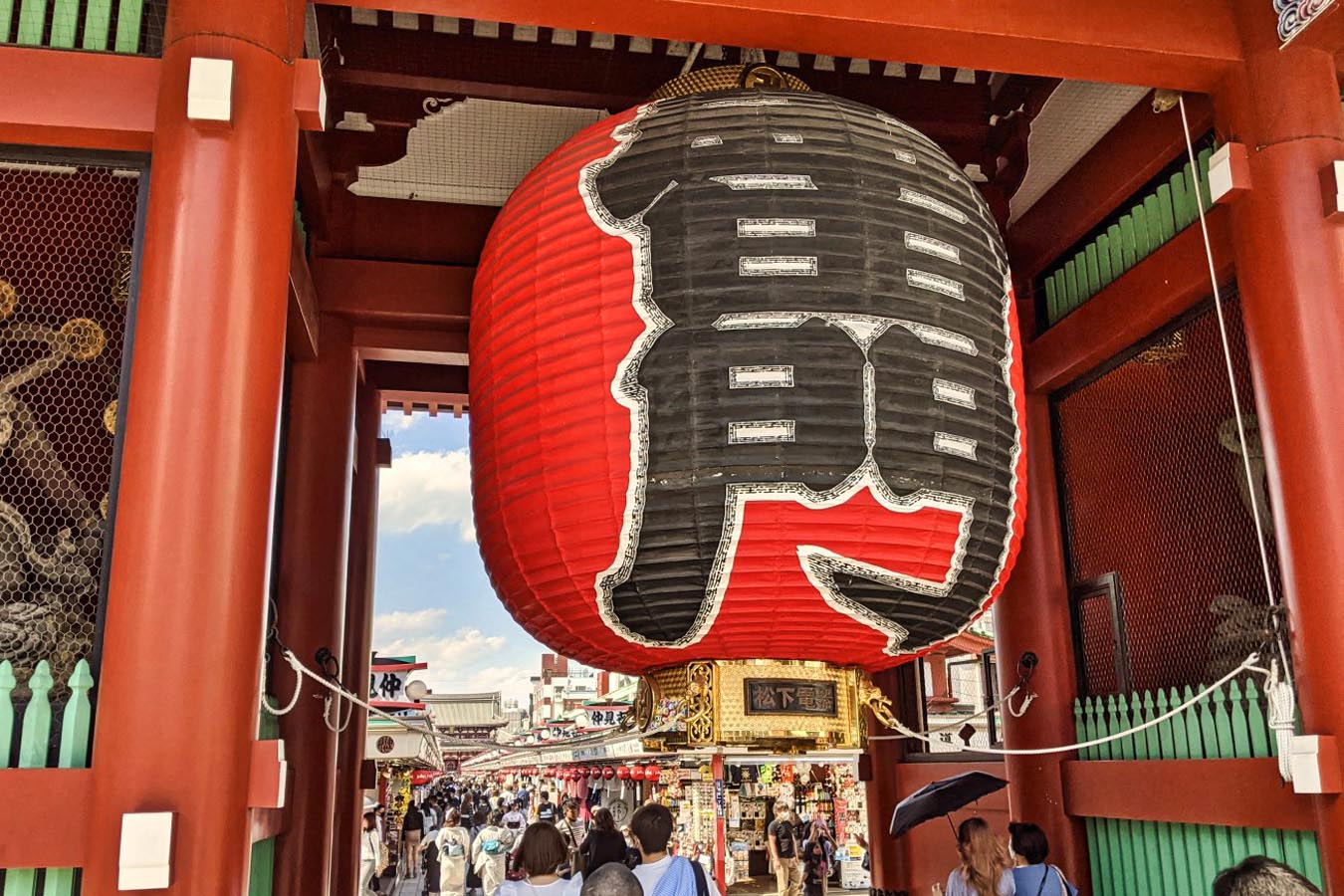
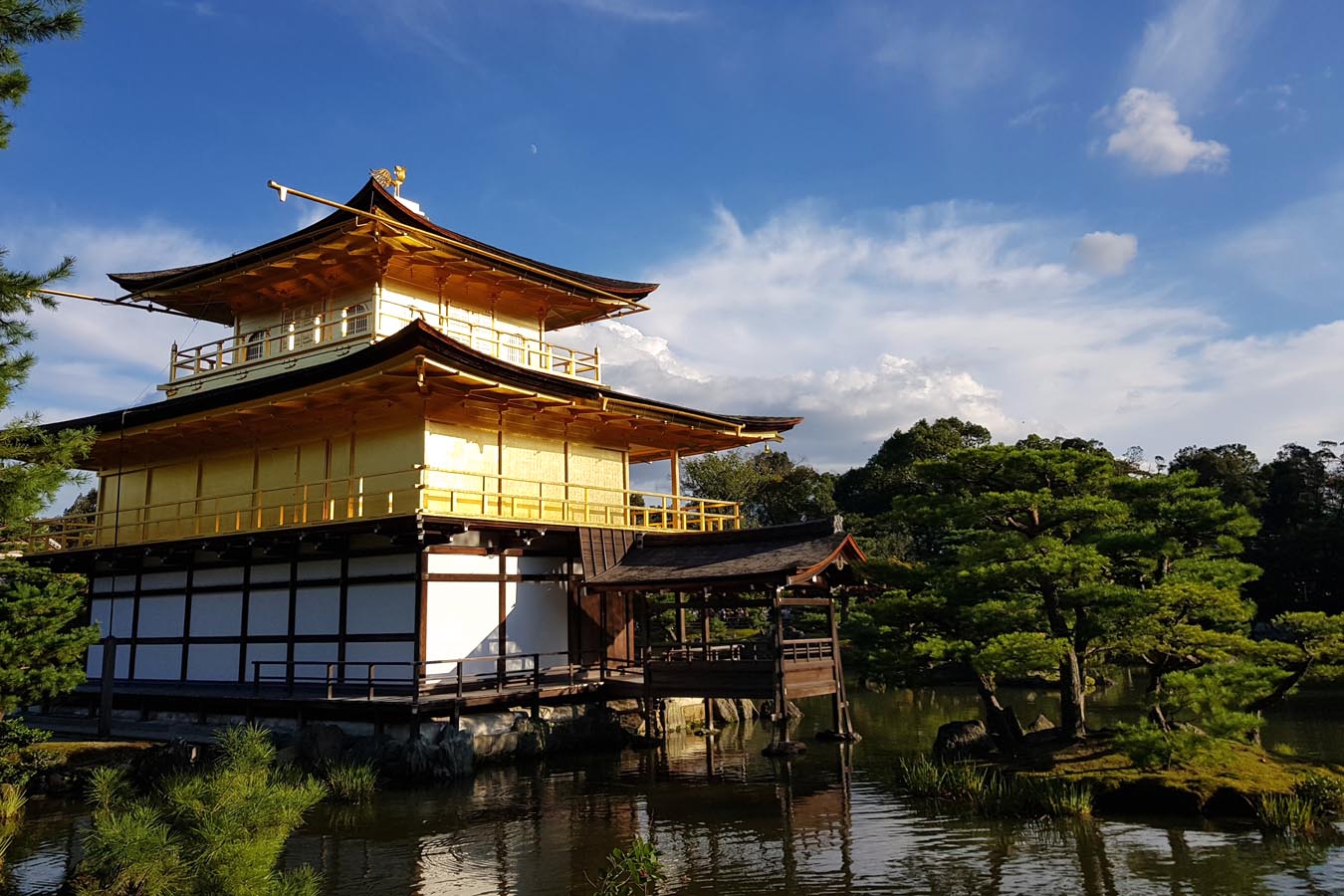

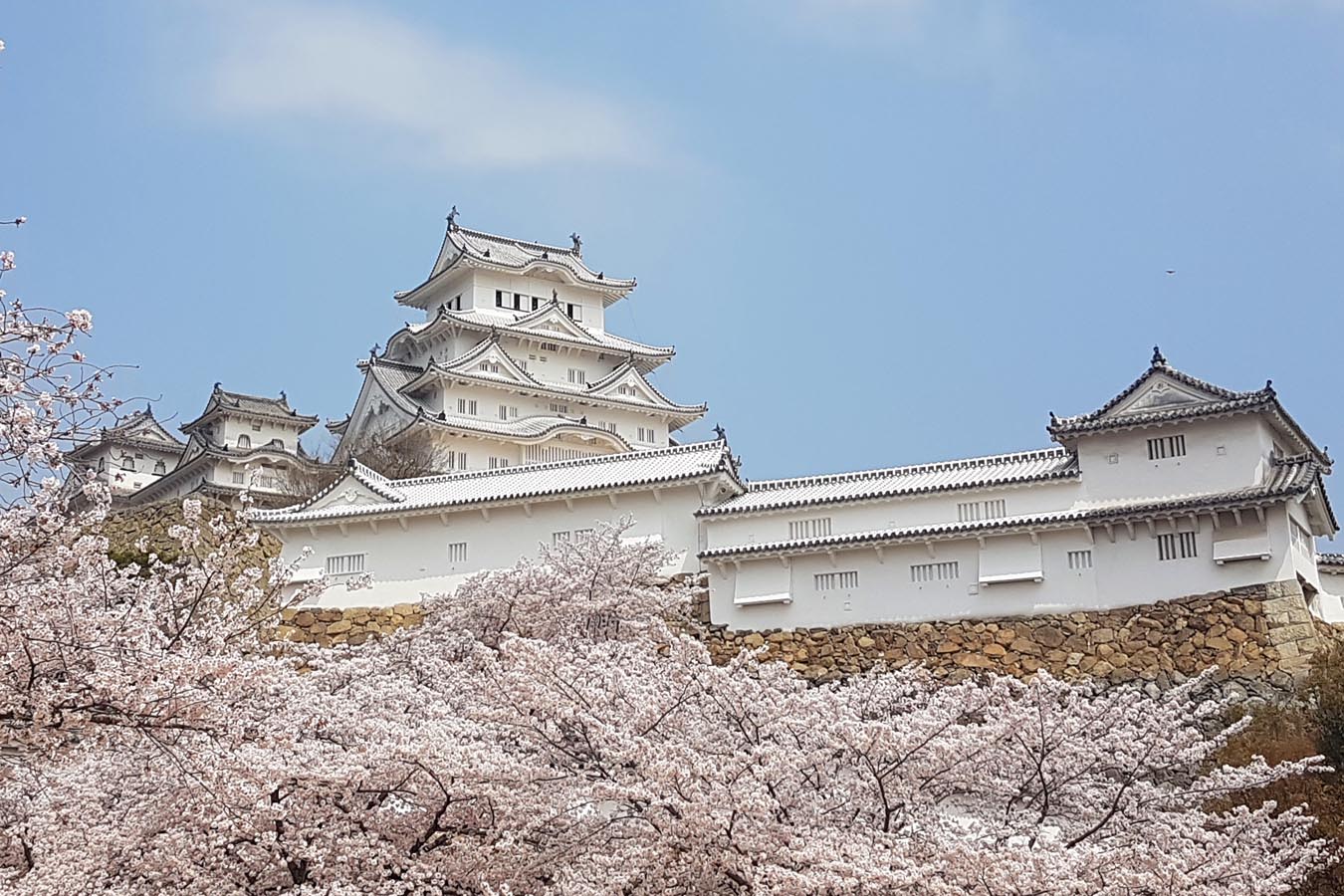
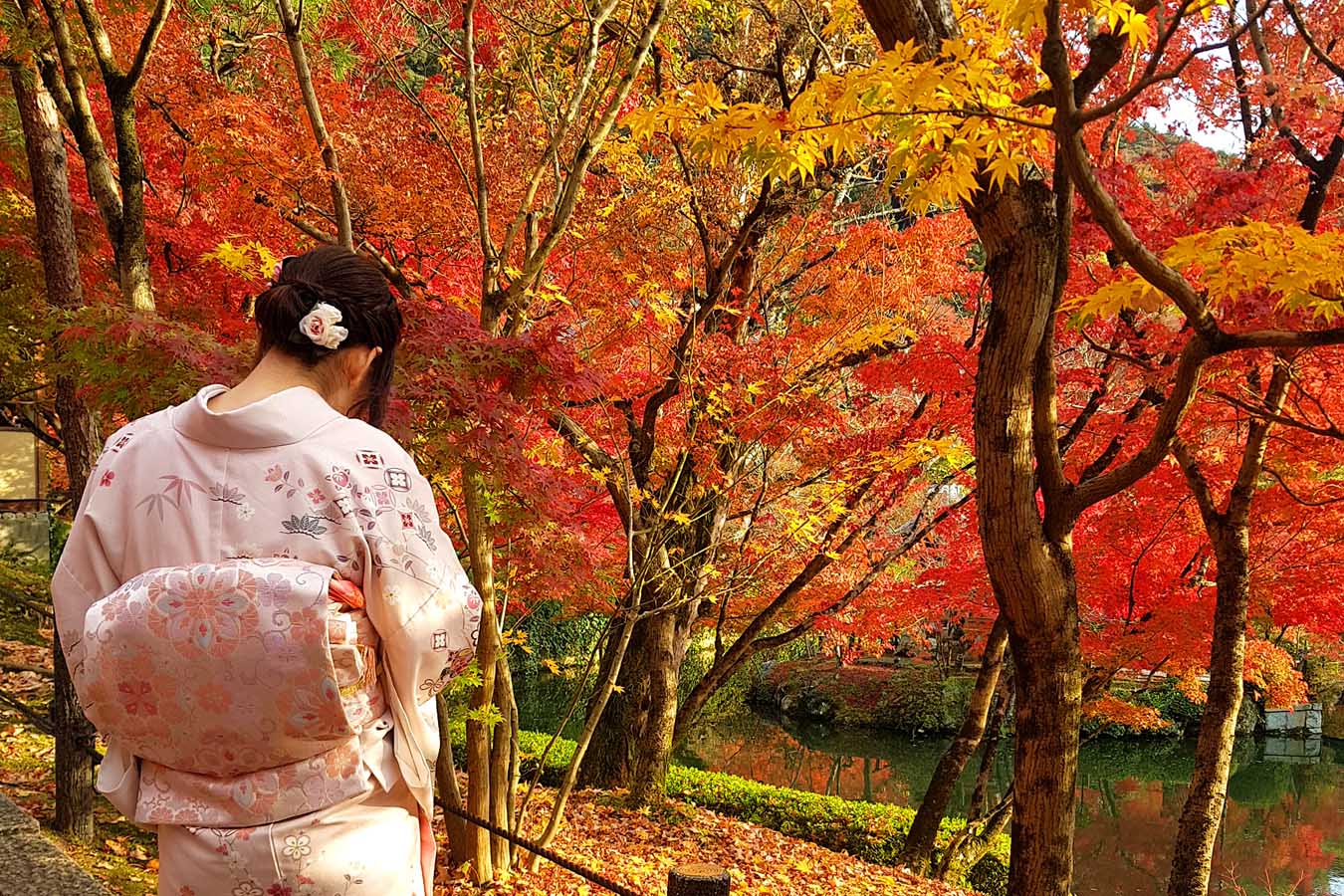
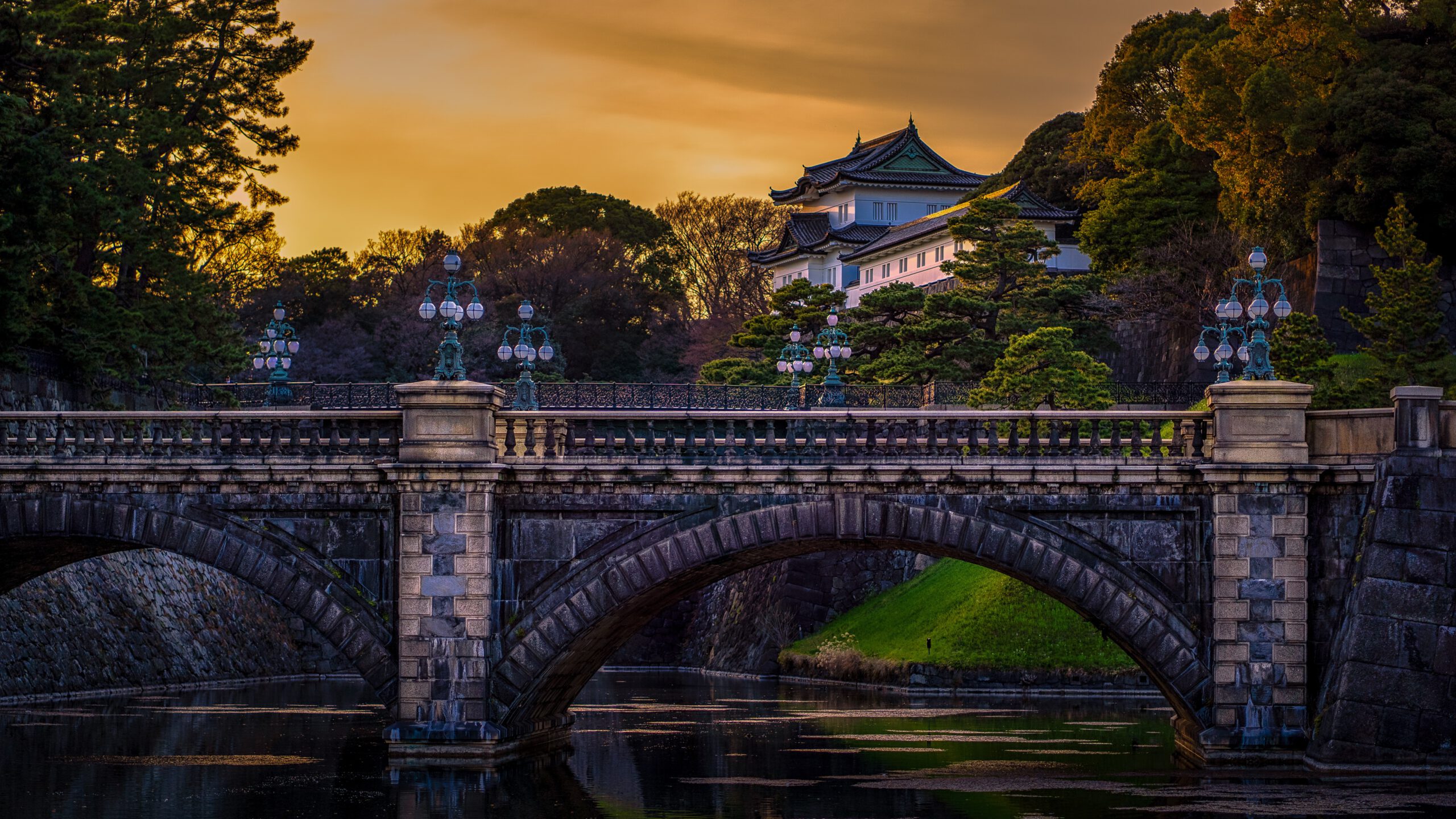
This Japan round trip takes you to the metropolises Tokyo and Osaka, as well as the cultural center Kyoto. You will discover tea plantations and bamboo forests, the Japanese Alps and the sacred Mount Fuji.
You will travel by bus, train and of course the super express train Shinkansen accompanied by a German speaking tour guide.
Highlights:
Optional post-stay Himeji - Okayama - Hiroshima (3 days)
Detailed prices on request
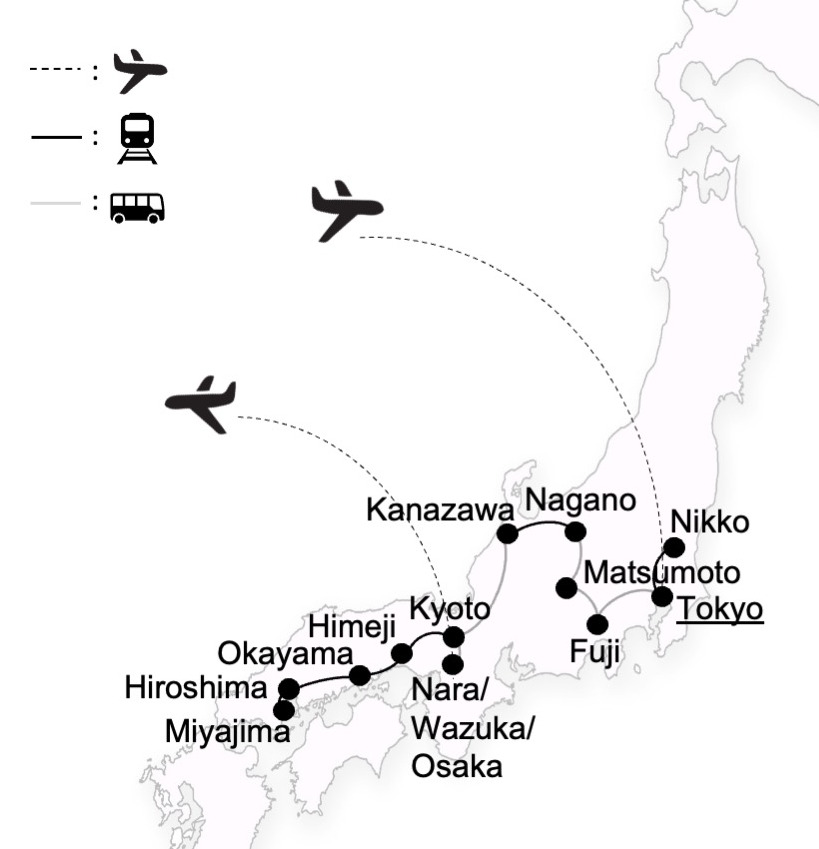
Shibuya by night
Arrival in Tokyo. You will be welcomed by your German tour guide who will take you to your hotel. Collect your first impressions during a short walk through the evening illuminated district of Asakusa. Here you will discover the faithfully reconstructed 17th century pilgrimage street Nakamise-dori. century, which leads under huge paper lanterns to the main Buddhist shrine, the Sensoji temple. Temple. We recommend you to have a first Japanese dinner in a typical Japanese Japanese restaurant. Your tour guide has perfect insider recommendations for this.
UNESCO World Heritage Nikko
Today, explore Tokyo on your own or join our optional day trip. Optional: Day Trip to Nikko: As a Japanese proverb claims, "Never say kekko (magnificent) until you've seen Nikko." You will drive to the famous UNESCO World Heritage Sites of Nikko. These include the mausoleum of the first Shogun of the so-called Edo period, the Toshogu Shrine, whose incredibly magnificently decorated buildings are with gleaming gold plating will leave you speechless. The equally impressive Rinnoji Temple at the foot of the complex, with its three gigantic main statues, will give you an impression of this, with what great reverence pilgrims must have stepped in front of these votives of Buddhism in the 17th century. must have stood before these votives of Buddhism. For here, as in no other place in Japan, the two world religions of Japan meet in close proximity: Shintoism and Buddhism. Shintoism and Buddhism. Upon your return to Tokyo, we recommend a trip to the Kabuki district. No other place in the world in the world can you find a similar density of neon signs. Tokyo by Night: simply incomparable!
Chureito Pagoda on Mount Fuji
Today we leave the largest metropolitan area of the island nation and head to its holiest mountain, Mount Fuji-san. By coach, you will first drive along the south side of Mount Fuji and visit the architecturally masterful Fuji World Heritage Center. Fuji World Heritage Center to learn more about the geological history of this still active volcano and the history of this still active volcano and its five natural lakes. Not far from the Center is the UNESCO World Heritage Site of Fuji-Hongu-Sengen-Taisha Shrine, which also houses the patron deity Konohanasakuya-hime, the patron deity of Mount Fuji. The foundation of the shrine dates back to prehistoric times and reflects the fact that Mount Fuji has always been revered as the country's holiest mountain. You will then visit the museum village of Saiko Iyashi-no-Sato Nenba, whose old village houses are characterized by with thick brushwood roofs, which are called "gassho" (hands folded in prayer) because of their shape. hands folded in prayer. You will take a walk through the village and get a glimpse of the reality of life reality of life of the people of the Middle Ages. In the afternoon, you will continue to Lake Kawaguchi. After a short ascent, you will visit the Chureito Pagoda. Pagoda and enjoy a perfect view of Mount Fuji, weather permitting. Afterwards check in at your accommodation, which has its own hot spring (Onsen). Take the opportunity for an extensive bath and let the impressions of the last days pass in review. pass. In the morning, you will travel by coach to historic Nara (approx. 40 minutes). Guided tour of the national treasures Kōfuku-ji, Todai-ji Temple and Nara Park. In the afternoon, drive to the Japanese tea fields around Uji in southern Kyoto. Guided tour and tea tasting included. Overnight at a family-run inn. Dinner together with the Japanese hosts.
Bathing Japan macaques in Jikokudani
After breakfast, today we will continue our journey into the depths of the Alps by comfortable coach. The first stop stop in the charming town of Matsumoto. You will visit the first castle complex on our journey and its characteristic black castle tower. Due to its color, it has been nicknamed is one of the oldest in Japan and will take you back to the time of the samurai and feudal lords. and feudal lords. The highlight of the day awaits us in the depths of the forests of Nakano: the Jigokudani Monkey Park. The Japan macaque packs that live in the wild here gather every day to to warm up in the hot spring pools preserved here in cold weather. Who does not know them, the photos of the monkeys bathing, relaxing in the hot spring pool even in heavy snowfall. (Walking time: about 2 hours) In the late afternoon you will arrive at your hotel in the alpine capital Nagano. If you still have some energy for a short walk, visit the evening illuminated pilgrimage temple Zenkoji with our guide. Zenkoji Pilgrimage Temple, the city's main shrine, which, according to legend, houses Japan's oldest Buddha statue, which was brought to the Land of the Rising Sun by Korean monks in the 6th century. came.
Korakuen convertible garden
Of course, a trip to Japan should not be without a ride on the most punctual train in the world, the Shinkansen Super Bullet Express. The journey from Nagano to Kanazawa of about 240 km takes just 90 minutes. Optionally, enjoy a classic bento (lunch boxes also sold at the station) on the ride, as many Japanese do. Kanazawa, which translates as "the marshes of gold," has retained much of its feudal-era charm as an old samurai stronghold. This includes one of the three most beautiful gardens in Japan: the Kenrokuen. In this gigantic changing garden from the 13th century, there are picturesque views at any time of the year. Especially at the time of cherry blossom and autumn foliage color, this is one of the favorite places of all Japanese. In Samurai Villa Nomura in the immediate vicinity of the garden you will dive even deeper into the history of the katana bearers. In the afternoon you will visit the geisha district of Higashi-Chaya, which has retained much of its medieval charm. The countless candy manufactories also invite you to taste them. A jaunt through the hustle and bustle of Omicho Market rounds out the day. Check-in at the centrally located hotel in Kanazawa.
The most punctual train in the world - Shinkansen
From Kanazawa today we continue along the coast into the mountains behind the big city of Fukui towards Kyoto. We stop in the medieval town of Omihachiman. After a short, optional climb to the town's Buddhist shrine, we enjoy scenic views of Japan's largest inland lake, Lake Biwa. It's past the town's Shinto shrine for a stroll along the picturesque Old Town Canal. We also visit one of the town's many revitalization projects. In Omihachiman, numerous young Japanese have renovated houses threatened by decay and demolition and converted them for modern use, fighting the effects of demographic change that affects almost all rural areas of Japan. Just before entering the ancient capital of Kyoto, another highlight of this trip awaits you: Fushimi-Inari Shrine, with its thousands of red torii gates and fox statues, is one of the most important shrines in Japan and a world-famous photo motif. In fact, it is now the most visited shrine in Japan and also part of Kyoto's UNESCO World Heritage Site. Check-in at the centrally located hotel in Kyoto.
Thousands of red torii gates at Fushimi Inari Shrine
Today the old imperial capital is waiting to be discovered by you. Already founded at the end of the 8. Century, Kyoto is by far the historically most worth seeing city of Japan with the most UNESCO World Heritage Sites, as it was only slightly damaged during the Second World War. during the Second World War. Following the example of the city's population, which is one of the most sustainable in Japan (keyword: Nature conservation), we set out today by bicycle. We start with probably the most famous sanctuary in Japan: the UNESCO World Heritage Site of the Golden Temple Kinkakuji. This three-story pavilion, covered with more than 20 kilos of gold, dates back to a temple in the 14th century and, with its garden, is considered the epitome of classical Japanese aesthetics. aesthetics. From here, we cycle through idyllic side streets to the traditional Orinasukan weaving mill in the Nishijin district. district of Nishijin, where thick brocade fabrics, some with gold and silver threads, are still woven by hand. Through Kyoto's large city garden, we now head to the old Gosho Imperial Palace. Most of the buildings, the throne hall and the beautiful gardens were largely rebuilt in the 19th century and the grandfather of the current emperor, Hirohito, spent his youth here. The tour continues past the Heian Shrine. Built in 1895 to commemorate Kyoto's 1,100th anniversary, this complex is a scaled-down replica of the of the former first imperial palace of the 9th century and impresses with its scarlet painting and dark its dark green roofs. Now we head along one of the city's most beautiful bike routes. Passing ancient temples, whose foundations date back to the 12th century, we cycle through the Maruyama Park and past the Kodaiji Temple to the hills of the UNESCO World Heritage Site: the Kiyomizu Temple. We lock the bikes and enjoy the view from the wooden terrace, from which in the Middle Ages young gentlemen plunged 13 meters into the depth as a test of courage. After a short breather in the hustle and bustle of the Ninen- and Sannen Zaka Hill below the temple, we return to the hotel by bike. After our return, you should enjoy the culinary delights of one of the many restaurants in the city. restaurants of the city. Your tour guide will be happy to help you with this. It We recommend that you combine this with a visit to the geisha district of Gion. Perhaps you will meet one of the one of the geisha wearing white make-up, who are on their way to one of the teahouses. teahouses.
The deer in Nara are considered sacred
Explore Kyoto on your own today or join today's day trip. Optional day trip to Nara and Wazuka tea plantations: Head to the cradle of Japanese culture, the small town of Nara. Among the UNESCO world heritage sites, the largest wooden building in the world, the Todaiji Temple, which is also the largest cast bronze in the world, and the "Golden Hall" of Kofukuji Temple, which was rebuilt by 2018, which also boasts a five-story pagoda dating back to the 15th century. But it is not only for its sanctuaries the city is known for. Tame but wild sika deer roam the city in packs and can be fed. the city and can also be fed. But beware. If the deer smell that you are carrying the locally sold "deer cookies, funny scenes with the snapping and pinching four-legged creatures can occur. can occur. In the hills of Wazuka, which are dotted with tea plantations, you will then devote yourself to what is probably most important drink of Japan. After an introduction into the tea cultivation and tasting, it is called with touch! Together with the villagers you will prepare mochi sweets with matcha (powdered green tea). green tea), the ingredients of which are of course also from the region. Use your last evening in the fascinating city of Kyoto for a walk in the Pontocho district. In the alleys directly along the Kamogawa River, one restaurant follows the next.
Sayonnara Japan!
Airport transfer to Kansai International Airport. Sayonara!
Himeji Castle Complex
The Shinkansen train takes less than 45 minutes from Kyoto's main station to Himeji, 120 kilometers away. Himeji, 120 kilometers away. Here you will visit the famous UNESCO World Heritage Site, the Himeji Castle complex, which has been nicknamed "Silver Heron" for its white exposed mortar. Besides the interior of the tower, which is still an original from the 17th century, we will explore the numerous outbuildings and and get intoxicated by the pink blossoms of hundreds of cherry trees in springtime. Afterwards, let us take you back to the time of the samurai once again. At the end of the 17th century the Ikeda Tsunamasa, a samurai prince, created a huge garden in Okayama called Korakuen. Korakuen, which loosely translates as "first the work, then the pleasure. Incidentally, this UNESCO World Heritage Site is also considered one of the three most beautiful gardens in Japan. And rightly so: even Mount Mount Fuji can be climbed to its crater here in miniature replica. You will arrive in Hiroshima in the early evening. For dinner you will not only be served typical Japanese food, but also a but a highlight of Hiroshima's cuisine: Okonomiyaki. The large slices of dough, which are mixed with vegetables and meat with vegetables and meat, are topped with various hearty toppings and then covered with the typical okonomiyaki sauce. Okonomiyaki sauce. Enjoy your meal!
Miyajima Island Floating Torii
After breakfast, you will go directly to the nostalgic Hiroshima streetcar, which will take you comfortably to the Mijayima ferry port in Hiroshima Bay. From here you will arrive after a short crossing and with the best panoramic view of the striking mountain formations to Miyajima Island. The island is considered one of the holiest islands in the Shinto faith, which is why neither birth nor death is allowed on it. Until beginning of the 19th century, even women were forbidden to enter the island. From the boat we have the large red torii shrine gate in the water and head to Itsukushima Shrine, which floats on the water at high tide. which seems to float on the water at high tide. This shrine, first built in the 12th century, preserves the souls of the three female water goddesses, Tagorihime, Tagitsuhime, and Ichikishimahime, who are vowed to happy travel and safe return. In addition to being honored as a UNESCO World Heritage Site the view of the shrine ranks as one of the three most beautiful landscapes in Japan. In the early afternoon, return ferry and streetcar back to Hiroshima and spend time in the Peace Park and the Atomic Bomb Atomic Bomb Museum to the city's sad past. At 8:16 a.m. on August 6, 1945. the city became the first target of a wartime use of nuclear weapons. The port city was almost and only a few buildings, among them the so-called "Atomic Bomb Dome", survived the survived the explosion, badly damaged. You can use the evening to review the experiences of the day and to spend a little and to spend a little time in the lively
The night view from Shibuya Scramble skyscraper
Airport transfer and return flight
Kaiserdamm 105, 14057 Berlin
Takanoha Square 5th floor, 331 Kamiyanagicho, Shimogyo Ward, Kyoto, 600-8099 Japan
ジェイナビゲーター合同会社
〒600-8099 京都府京都市下京区上柳町331 タカノハスク エア5階